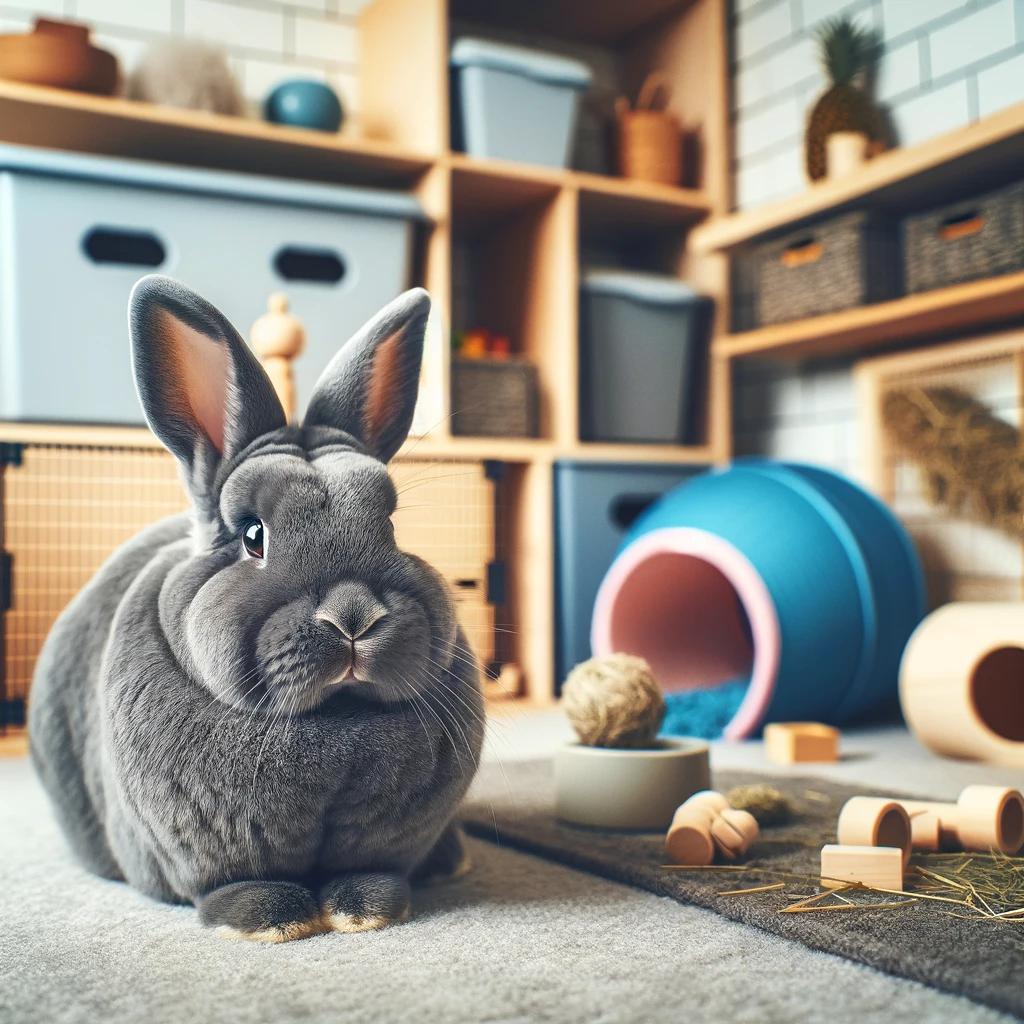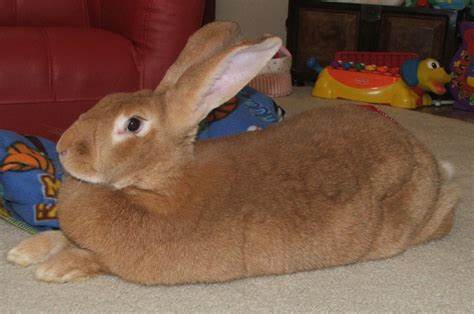Flemish Giant Rabbit as a Pet
Imagine a rabbit, but not just any bunny. Picture the Flemish Giant Rabbit, a gentle giant in the world of rabbits. This breed is fascinating, both for its size and its nature.
Embark on a journey to uncover the roots and distinctive traits that render Flemish Giant Rabbits unparalleled companions. We’ll guide you through setting up the perfect home for these giants and dive into their dietary needs to keep them healthy and happy. Health issues are also on our radar; we want your Flemish Giant to thrive for years.
But owning one comes with challenges too. By weighing the pros against cons, we aim to give potential owners all they need to decide if a Flemish Giant Rabbit is right for them.
Table Of Contents:
- Flemish Giant Color Variations
- Understanding Flemish Giant Rabbits
- Creating a Suitable Habitat for Flemish Giants
- Dietary Needs and Nutrition
- Health Issues and Lifespan
- Pros and Cons of Keeping a Flemish Giant Rabbit
- Gentle Giants Make Good Pets
 AI illustration of a blue flemish giant
AI illustration of a blue flemish giant
Flemish Giant Color Variations
When considering adding a Flemish Giant rabbit to your family, choosing from their beautiful array of color variations is one of the most exciting aspects. Each color adds to the aesthetic appeal and brings its unique charm into your home. Let’s dive into some popular and rarer colors these gentle giants come in.
Fawn: A Golden Hue
The awn-colored Flemish Giants boast a warm, golden coat that captures the essence of sunlight. This hue is particularly sought after for its vibrant appearance and can add a bright spot to any pet owner’s life. Their lustrous fur requires regular grooming to maintain its shine and health.
Sandy: Earthy Elegance
Sandy Flemish Giants are adorned with coats resembling sandy beaches, exhibiting an earthy brown tone that exudes natural elegance. They blend well in various settings due to their neutral coloration, making them a versatile choice for prospective pet owners interested in aesthetics as much as companionship.
In terms of rarity among these majestic creatures:
- Blue: Blue Flemish Giants carry a dilute gene, giving them their distinct blue-grey coat, which can be less common amongst breeders. The serene beauty of this variation makes it highly desirable among enthusiasts looking for something truly special.
- Light Gray (Iron Gray): Also known by fanciers as “Iron Gray,” this variation features distinctive ticking patterns across light gray fur, offering an almost mythical appearance reminiscent of ancient legends.
- White: White variants may not be exceedingly rare, but finding one with striking blue or pink eyes that perfectly exhibit all desired breed characteristics can be a challenging yet rewarding endeavor for collectors and lovers alike.
To ensure you get a healthy specimen regardless of color,
consider adopting from reputable sources such as local rabbit rescues or established breeders who prioritize animal welfare over mere aesthetics (House Rabbit Society). Remember always that while the outer beauty catches the eye initially, the gentle nature and personality traits typical of all Flemish Giants, irrespective of color, make them cherished pets worldwide.
Understanding Flemish Giant Rabbits
Flemish Giant rabbits are the gentle giants of the rabbit world, often called the ‘dogs’ of rabbits due to their docile and friendly nature. Originating from Belgium in the 16th century, these bunnies were not just pets but also bred for fur and meat. Nowadays, these towering bunnies capture hearts with their colossal stature and endearing dispositions.
Their size is no joke; a full-grown Flemish Giant can weigh up to 22 pounds. This hefty weight comes with an equally big heart. They thrive on interaction with humans and can be quite playful. Their coat colors vary widely, including black, blue, fawn, sandy, light gray, steel gray, and white.
However, this breed’s large size requires more space than your average bunny condo. Facts About Flemish Giants. Spacious living quarters allow them to stretch out fully and stay active, which is crucial for their well-being.
Creating a Suitable Habitat for Flemish Giants
Flemish Giant rabbits aren’t just big in size; their personalities are huge, too. To keep them happy, think of their habitat as a rabbit-sized castle. First off, space is key. These gentle giants need room to roam, stretch, and hop. A small cage won’t cut it.
Regarding bedding, comfort meets cleanliness with straw or aspen shavings—both are great choices that give your bunny a cozy spot to rest while keeping the area easy to clean. Avoid cedar or pine shavings, though; they can be harmful.
The right temperature matters more than you might think. Keeping their environment between 60-70°F ensures they’re not too hot or cold but just right. Think about how you feel at a comfortable room temperature—that’s what we aim for here.
Amazon has a wide variety of giant rabbit gear.
Dietary Needs and Nutrition
Feeding them isn’t about quantity alone; it’s a delicate balance of nutrition.
Hay: The Foundation of Their Diet
Hay isn’t just for horses. For Flemish Giants, it’s the cornerstone of good health, making up 70% of their diet. It keeps their digestive systems moving and teeth in check. Timothy hay is a favorite, but mixing grass hays adds variety to their munching routine.
Don’t skimp on quality here; fresh, dust-free hay ensures they’re not sneezing more than snacking.
Fresh Vegetables: A Splash of Color
Veggies are the spice of life for these gentle giants. Dark leafy greens like romaine lettuce and kale should be daily staples alongside occasional treats like carrots or apples—think moderation to avoid sugar spikes.
Bear in mind that not all veggies are bunny-friendly—a quick check can prevent upset tummies or worse.
Health Issues and Lifespan
This detailed manual, designed for animal enthusiasts, reveals the full spectrum of experiences in nurturing a Flemish Giant rabbit, from essential care practices to vital health recommendations.
Common Health Problems
The Flemish Giant rabbit breed is the gentle giant of the rabbit world, but even these big bunnies can face health challenges. Grasping the potential health setbacks these gentle giants may face is crucial for ensuring their joyous leaps continue well into the future.
Sadly, their size has a downside – joint issues such as arthritis can be more common in Flemish Giants than in smaller breeds. Keeping an eye on their weight and ensuring they have a soft resting place can help mitigate this risk. Additionally, the threat of gastrointestinal stasis looms, a dire situation in which the digestive tract may either decelerate significantly or halt altogether. Regular exercise and a diet high in hay will keep their gut moving and grooving.
Dental problems also loom large due to their continually growing teeth. Providing plenty of chew toys can prevent overgrowth and associated complications.
If you have questions about the health of your Flemish Giant rabbit breed, you can sign up for an online vet consultation with Ask A Veterinarian. They are available 24/7 to answer questions.
To avoid unexpected health costs, check out Pet Assure Mint.
Lifespan Expectations
These gentle giants can grace your home for 8 to 10 years with proper care. This means committing to regular vet check-ups since early detection of health issues greatly extends their lifespan.
Pros and Cons of Keeping a Flemish Giant Rabbit
Owning a Flemish Giant rabbit is like having a small dog: they’re sociable, large, and require space. But before you jump on the bunny bandwagon, consider both sides of the coin.
The Bright Side: Advantages
Flemish Giants are gentle giants known for their docile nature, making them great companions. Their ability to create deep connections with those caring for them is remarkable. Plus, these bunnies can be litter-trained pretty easily – talk about convenience. Their considerable stature ensures there’s ample to embrace and cherish, elevating the cuddle experience.
Challenges Ahead: Disadvantages
However, it’s not all fluffy tails and nose boops. Their size demands ample living space – think big. A regular rabbit hutch won’t cut it; these bunnies need room to roam. And let’s talk diet – feeding such a large breed isn’t cheap as they munch through more hay than your average rabbit. Lastly, because of their hefty build, they’re prone to health issues that can lead to heartache if not closely monitored.
Gentle Giants Make Good Pets
So, you’ve journeyed through the world of the Flemish Giant rabbit. From their humble origins to becoming gentle giants in our homes.
Diving into their needs, we uncovered how much space they crave and the specific diet that keeps them thriving. Healthwise, staying vigilant is key.
Owning one isn’t all hops and cuddles. Embracing the responsibility enriches your life with unparalleled fellowship.
Start by creating a loving environment for your Flemish Giant rabbit. Ensure the large and cozy area fosters a nurturing space. Keep their diet balanced; remember, hay is crucial.
To potential owners: weigh these insights carefully. A Flemish Giant could be your next big love or a challenge too great.


Comments are closed.